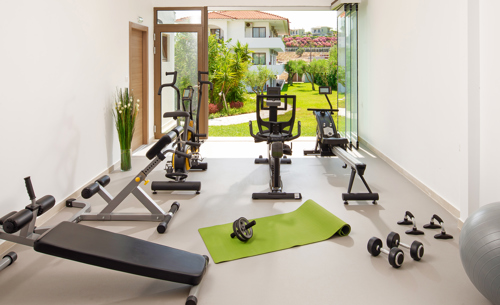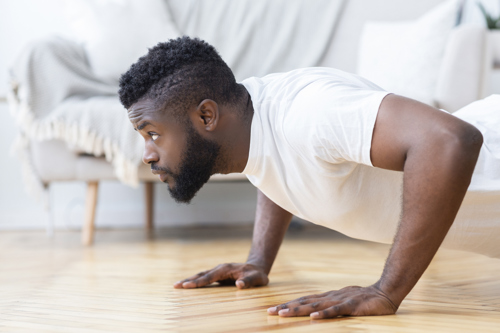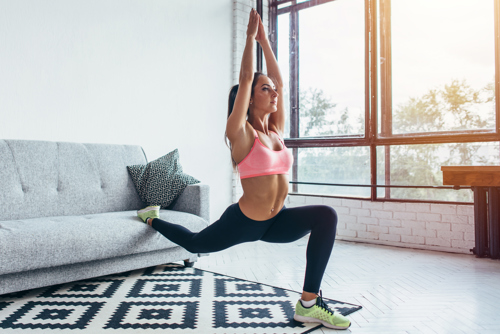Getting a gym membership can take your fitness routine to the next level, but for those who hate waiting for equipment, navigating crowded spaces and commuting, creating a workout space at home has plenty of advantages. With more and more workplaces now offering hybrid or remote opportunities (and an increase in on-demand fitness classes and wearable devices to track fitness progress), home gyms have become more appealing to fitness beginners and fanatics alike. If you’re not sure where to start, read on to learn exactly how to build a home gym that can help you hit your fitness goals and save some money in the process.
1. Is a Home Gym Right for You?
Home gyms offer a more personalized and stress-free environment for you to work out in. Whether it’s a stationary bike, treadmill or your standard weight rack, having a home gym allows you to build a “library” of your favorite fitness equipment — which is more budget-friendly over the course of one or several years, compared to paying a monthly or annual gym fee for equipment you never plan on using.
Here are some of the top benefits of building a home gym:
- Less peer pressure
- No travel time
- No wait time for equipment
- No need for gym bags
- A customized gym experience
- Play your own music while you exercise
- No membership fees or contracts
That said, if you like working out with your peers or taking advantage of commercial gym amenities — such as personal trainers, state-of-the-art equipment, pools, saunas and more — a home gym might not be the best option for you.

2. Find a Dedicated Space for Your Home Gym
For most people, the primary barrier to entry of having a home gym is space. Before you decide to invest in equipment, think about where your gym will go. If you have a shed in the backyard, a spacious garage or even a basement, you’re in luck — but even an empty corner of the living room can be transformed into the perfect fitness space.
Whatever area you choose, you’ll want to make sure it’s bright and has an even surface and good circulation. If natural light isn’t an option, choose bulbs that provide soft white light instead. Adding mirrors can also give the illusion of a brighter, more open space.
| Pro Tip: To create a space for your home gym, consider getting rid of any unused bulky items or moving them into a storage unit. |
3. Decide on Your Fitness Routine
One benefit of having a home gym is that you can customize it to your needs and workout preferences. Like a wardrobe, you can slowly collect fitness equipment over time, allowing you to discover through trial and error exactly what works for you — whether it’s dumbbells, resistance bands or something else altogether. Here are some basic starting points that you can use for a wide range of exercises:
- Yoga mat for stretching and laying on
- Resistance bands for strength training
- Jump rope for cardio
- Kettlebells or dumbbells for weight training
- Pull-up bar
- Foldable bench
- Rowing machine
- Sledgehammer
- Foam rollers

4. Find Equipment: Home Gym Ideas on a Budget
Cost is often the primary concern when building a home gym. Investing in long-lasting equipment can take time and money, but it’s absolutely worth it — and there are plenty of ways to snag high-quality fitness equipment without breaking the bank.
Browse Thrift Stores
While thrift stores can be hit or miss, they can be a great place to source low-cost, secondhand gym equipment. Stay tuned to your local thrift store’s “discount” days to get the best deal, and if it doesn’t have what you’re looking for, call every couple of months to see if the store has gotten the item you want.
Buy Secondhand
It’s easy to find secondhand fitness equipment in superb condition, whether it’s eBay, Craigslist or a neighbor’s yard sale. Here are some platforms to check out:
- Facebook Marketplace
- Craigslist
- eBay
- OfferUp
- LetGo
With these apps and online tools, you can refine your searches by distance, type of equipment and seller reviews. Before you start buying fitness equipment off the internet, however, there are some best practices to keep in mind:
- Use exact-phrase queries. This way, you can improve your search efficiency and spend less time browsing through unrelated results.
- Read seller reviews to ensure it’s not a scam.
- Try to negotiate the price before you buy the item. Often sellers will want to sell the item as quickly as possible and expect a price negotiation.
- Meet the seller in public to ensure your safety.
- Do not give the seller money before seeing the product. This will discourage scams.
Use Household Items
You don’t need anything fancy to get a stellar workout — in fact, many fitness experts are using furniture or household items they already have to get the most out of their session. For example, your couch can serve as a bench for tricep dips or elevate your legs for an ab workout. Dining room chairs can be used for balance or to suspend your leg during lunges. Even a wall can be used for timed wall sits. With a little creativity, you can create an efficient workout routine with little to no money.
Try Bodyweight Exercises
Using your natural body weight for resistance or strength training is convenient, as you can do the exercises any place and at any time, with zero equipment. Bodyweight exercises include:
- Pushups
- Situps
- Pullups
- Lunges
- Squats
- Planks
You don’t have to solely practice bodyweight exercises — incorporating them into a broader routine can make your workouts more robust without requiring additional equipment or costs.

5. Keep Your Home Gym Clean and Organized
Once you have your equipment and develop a workout plan, keeping your space clean and organized is an essential part of maintaining a home gym. After each workout, be sure to wipe down all surfaces and equipment with a disinfectant wipe (try using a cloth rag and an eco-friendly DIY solution to be more sustainable). Then, place your equipment back on any shelves or put household items back in their usual spots to prevent the area from feeling cluttered. This is especially true if you’ve built your home gym in a small bedroom or living room that doesn’t have much space to begin with.
If your home gym items start to feel like an eyesore that clashes with your existing decor, invest in a folding screen or room divider.









